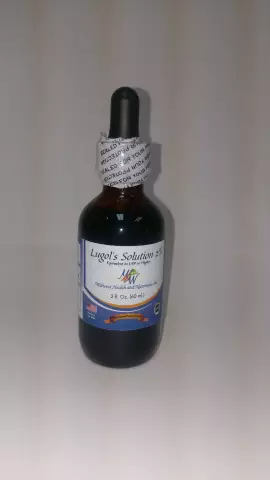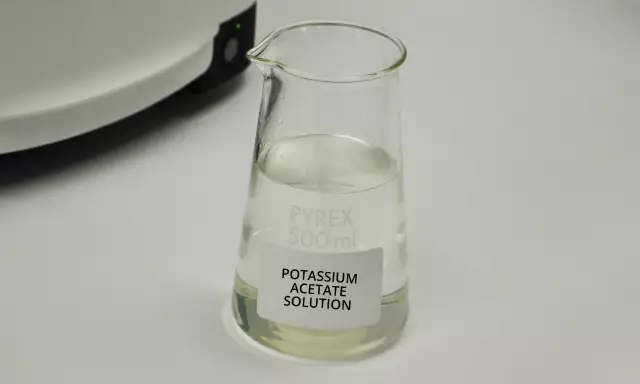- Author Rachel Wainwright [email protected].
- Public 2023-12-15 07:39.
- Last modified 2025-11-02 20:14.
Flavamed
Flavamed: instructions for use and reviews
- 1. Release form and composition
- 2. Pharmacological properties
- 3. Indications for use
- 4. Contraindications
- 5. Method of application and dosage
- 6. Side effects
- 7. Overdose
- 8. Special instructions
- 9. Application during pregnancy and lactation
- 10. Use in childhood
- 11. In case of impaired renal function
- 12. For violations of liver function
- 13. Drug interactions
- 14. Analogs
- 15. Terms and conditions of storage
- 16. Terms of dispensing from pharmacies
- 17. Reviews
- 18. Price in pharmacies
Latin name: Flavamed
ATX code: R05CB06
Active ingredient: Ambroxol (Ambroxol)
Producer: Berlin-Chemie AG / Menarini Group (Germany)
Description and photo update: 2018-23-10
Prices in pharmacies: from 23 rubles.
Buy

Flavamed is a drug with an expectorant effect.
Release form and composition
Dosage forms of Flavamed:
- tablets: white or almost white with a yellowish tinge, plane-parallel, round, with a one-sided line and beveled edges (10 pcs. in blisters, in a cardboard box 1, 2 or 5 blisters);
- oral solution: transparent, brownish or colorless, has a raspberry smell (in dark glass bottles of 60, 100 or 200 ml, in a cardboard box 1 bottle complete with a measuring spoon).
Composition of 1 tablet:
- active substance: ambroxol hydrochloride - 30 mg;
- auxiliary components: lactose monohydrate - 40 mg; corn starch - 30 mg; microcrystalline cellulose - 30 mg; croscarmellose sodium - 5.3 mg; povidone (K-30) - 4 mg; magnesium stearate - 0.7 mg.
Composition of 5 ml solution for oral administration:
- active substance: ambroxol hydrochloride - 15 mg;
- auxiliary components: benzoic acid - 5.75 mg; 85% glycerol - 500 mg; 70% non-crystallizing sorbitol - 2500 mg; hyetellose - 5 mg; raspberry flavor No. 516028 - 5 mg; purified water - 2719.25 mg.
Pharmacological properties
Pharmacodynamics
Flavamed is one of the expectorant mucolytic drugs.
Ambroxol is an active N-demethylated metabolite of bromhexine with expectorant, secretolytic and secretomotor effects.
The main effects of the drug:
- an increase in the content of mucous secretions, which leads to the normalization of the disturbed ratio of the mucous and serous components of sputum, as well as the release of a surfactant (surfactant) in the bronchi and alveoli;
- stimulation of serous cells of the glands of the bronchial mucosa;
- increased motor activity of the ciliated epithelium and mucociliary transport of sputum.
When taken orally, the effect develops on average after 30 minutes, its duration is dose-dependent and varies from 6 to 12 hours.
Pharmacokinetics
After oral administration, Ambroxol is almost completely and rapidly absorbed from the gastrointestinal tract. C max (maximum concentration of the substance) is reached in about 1-3 hours. The absolute bioavailability of the substance as a result of metabolism, which is associated with the effect of the first pass through the liver, decreases by about 1/3. Glucuronides, dibromantranilic acid and other formed metabolites are excreted by the kidneys.
Plasma protein binding varies within 80-90% (on average - 85%). Penetrates through the placental and blood-brain barriers, excreted in breast milk.
Metabolism occurs in the liver by conjugation with the subsequent formation of metabolites that do not have pharmacological activity.
T 1/2 (half-life) - from 7 to 12 hours. In total, T 1/2 of ambroxol and its metabolites is approximately 22 hours. It is excreted mainly by the kidneys, most (90%) - in the form of metabolites formed in the liver. Less than 10% of the amount excreted through the kidneys is ambroxol in unchanged form.
In patients with severe renal impairment, T 1/2 of ambroxol metabolites increases. Severe liver disease does not affect this indicator.
Significant elimination of ambroxol by dialysis or forced diuresis is not observed (associated with a high degree of binding to plasma proteins, a large volume of distribution, as well as a slow reverse distribution from tissues into the blood).
Indications for use
Flavamed is prescribed for the treatment of acute / chronic diseases of the respiratory tract, which are accompanied by impaired secretion and transport of sputum:
- bronchitis in acute and chronic course;
- chronic obstructive pulmonary disease;
- pneumonia;
- bronchiectasis;
- bronchial asthma with difficulty in sputum discharge.
Contraindications
Absolute:
- congenital fructose intolerance (solution);
- age up to 6 years (tablets);
- I trimester of pregnancy;
- individual intolerance to the components of the drug.
Relative (Flavamed is prescribed with caution under medical supervision):
- violations of bronchial motility and the formation of a significant amount of secretion (in particular, with the rare syndrome of immobile cilia);
- renal / hepatic impairment;
- peptic ulcer of the stomach and duodenum;
- age up to 2 years (solution);
- II - III trimesters of pregnancy and the period of breastfeeding.
Instructions for use of Flavamed: method and dosage
The drug is taken orally, preferably after meals.
Flavamed tablets should be taken with a sufficient amount of liquid, not chewed. For correct dosing of the solution, it is recommended to use a measuring spoon.
Standard dosing regimen (30 mg = 1 tablet = 2 scoops of solution):
- adults and children from 12 years old: the first 2-3 days - 3 times a day, 30 mg, then the frequency of administration is reduced to 2 times a day; if necessary, in order to enhance the therapeutic effect, it is possible to prescribe 60 mg 2 times a day;
- children 6-12 years old: 2-3 times a day, 15 mg;
- children 2-6 years old (solution only): 3 times a day, 1/2 measuring spoon;
- children under 2 years of age (solution only): 2 times a day, 1/2 measuring spoon.
Patients with renal insufficiency / severe liver damage need to increase the time between doses or take Flavamed at a lower dose.
The duration of admission is determined individually. You should not take the drug for more than 4-5 days without medical advice.
Side effects
Possible adverse reactions (> 0.1% and <1% - infrequently; <0.01% - very rare):
- digestive system: infrequently - constipation, dry mouth, diarrhea (tablets); with prolonged use - nausea, abdominal pain, vomiting (solution and tablets);
- dermatological reactions: very rarely - Stevens-Johnson syndrome, toxic epidermal necrolysis (tablets);
- allergic reactions: infrequently - urticaria, skin rash, angioedema (tablets), facial edema (solution), shortness of breath, hyperthermia; very rarely - anaphylactic shock;
- others: very rarely - headache, weakness, exanthema, dysuria (tablets).
Overdose
The main symptoms: vomiting, short-term anxiety, nausea, diarrhea; in the case of taking the drug in significantly exceeding the recommended doses (above 25 mg / kg per day) - drooling, lowering blood pressure.
Therapy: intake of fat-containing products, artificial vomiting, gastric lavage in the first 1-2 hours after taking Flavamed, symptomatic treatment.
special instructions
In order to maintain the secretolytic action of Flavamed during the period of therapy, it is necessary to ensure that a sufficient amount of fluid is supplied to the body.
Patients with severe renal insufficiency should consider the possibility of accumulation of ambroxol metabolites formed in the liver.
5 ml of solution contains 1750 mg of sorbitol, which corresponds to 0.15 XE (grain units).
Application during pregnancy and lactation
- I trimester of pregnancy - therapy is contraindicated;
- II - III trimesters and the period of breastfeeding - the drug can be prescribed with caution.
Pediatric use
- up to 6 years - Flavamed tablets are contraindicated;
- up to 2 years - Flavamed in the form of a solution should be administered with caution.
With impaired renal function
Flavamed is prescribed with caution to patients with renal insufficiency.
For violations of liver function
According to the instructions, Flavamed is prescribed with caution to patients with hepatic insufficiency.
Drug interactions
Possible interactions:
- drugs with antitussive action (suppressing the cough reflex): weakening of the cough reflex, which can lead to the appearance of congestion in the bronchi;
- cefuroxime, amoxicillin, doxycycline, erythromycin: an increase in their penetration into the bronchial secretions.
Analogs
Flavamed analogues are: Ambrolor, Ambrosan, Ambrobene, Ambrohexal, Ambroxol, Medox, Bronchorus, Halixol, Suprima-kof, Remebrox, Lazongin, Lazolvan, Bronhoxol and others.
Terms and conditions of storage
Store at temperatures up to 25 ° C. Keep out of the reach of children.
Shelf life:
- tablets - 2 years;
- solution - 3 years.
After opening the package, the solution can be taken for 6 months.
Terms of dispensing from pharmacies
Available without a prescription.
Reviews about Flavamed
According to reviews, Flavamed is an effective and affordable drug that promotes sputum discharge. Opinions differ regarding taste and smell. The development of side effects is rarely reported. In some cases, it is noted that the effect develops slowly, or it is insufficient.
Price for Flavamed in pharmacies
The approximate price for Flavamed is:
- tablets (20 pcs. in a package) - 121-156 rubles;
- solution (1 bottle 100 ml) - 164-195 rubles.
Flavamed: prices in online pharmacies
|
Drug name Price Pharmacy |
|
Flavamed max 60 mg effervescent tablets 10 pcs. RUB 23 Buy |
|
Flavamed 30 mg tablets 20 pcs. RUB 137 Buy |

Maria Kulkes Medical journalist About the author
Education: First Moscow State Medical University named after I. M. Sechenov, specialty "General Medicine".
Information about the drug is generalized, provided for informational purposes only and does not replace the official instructions. Self-medication is hazardous to health!






